
You may not have heard the term “latissimus dorsi” before, but I’ll bet you know what it is: This large, flat, V-shaped back muscle is more commonly known as your “lats.”
And if you’ve been unfortunate enough to pull a lat muscle, you know that latissimus dorsi pain can not only be debilitating, it can seriously affect your ability to perform everyday activities.
In this article, I’ll cover the most common causes and symptoms of latissimus dorsi pain, as well as the best ways to treat and prevent it.
Table of Contents
[1] Common causes of latissimus dorsi pain
[2] Symptoms of latissimus dorsi pain
What causes latissimus dorsi pain?
The latissimus dorsi is one of the largest muscles in your body. It stretches across the width of your back in a “V” shape, covering the bottom tip of your scapula, or shoulder blade.
It’s connected to your spine, hipbone and the bone in your upper arm.
Your lats are responsible for depressing your shoulders and extending, adducting (bring closer to the body) and internally rotating your arms.
Because of its size and the important role it plays in moving your upper body, an injury to the latissimus dorsi muscle can cause debilitating pain and severe loss of function.
While it’s possible that trauma or surgery could lead to latissimus dorsi pain, the most common cause of pulled lats is overuse, especially when performing activities that involve pulling or throwing motions.
When we perform these types of motions repeatedly — or perform them using poor technique — we set ourselves of for pulled muscles. or muscle strains.
A latissimus dorsi strain can occur when taking part in sports such as baseball, tennis, rowing or swimming, or it could occur while taking care of everyday tasks like shoveling snow, chopping wood — or simply reaching your arms above your head repeatedly.
You can also injure your lats during gym workouts.
Think about these types of repetitive motions. They throw your body — and your muscles — out of balance.
That’s why when we talk about latissimus dorsi pain, it’s important to understand that what we’re really talking about are muscle imbalances.
Sometimes, latissimus dorsi pain and injury is the result of a postural dysfunction.
The most common postural dysfunction associated with lat muscle pain is forward head posture.
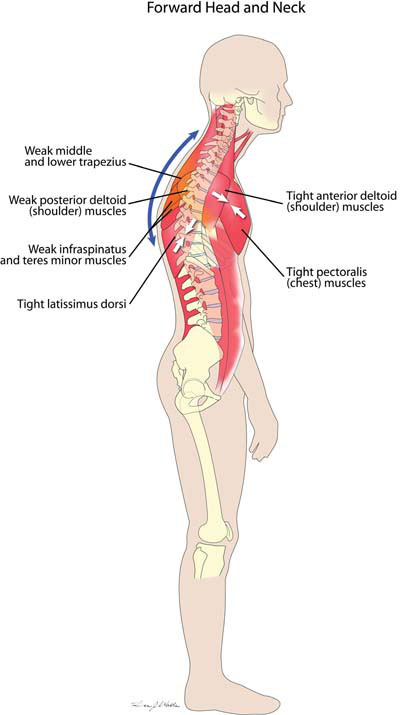
Your lats are one of the primary muscles responsible for good, stable posture.
When you spend all day hunched over, with your head jutting forward of your body’s center line, it pulls at your latissimus dorsi muscle, causing strain and sometimes trigger points.
You can learn more about how to correct forward head posture here. but the exercises below will help put your body back in balance.
Key Takeaway: Muscle imbalances and postural dysfunctions are the most common cause of latissimus dorsi pain.
What are the symptoms of latissimus dorsi pain?
Because the latissimus dorsi is such a large muscle, the exact location of your pain may vary.
In fact, you may not even realize that you have pulled lat muscles, as some people just feel generalized back pain.
Most often, though, latissimus dorsi pain is felt in the shoulders, back, or upper or lower arms.
Back pain can either be in the lower back or the mid- to upper back. The pain from a latissimus dorsi strain may also extend down the inside of your arm to your fingers.
Please note that if your latissimus dorsi pain is accompanied by a fever or pain in your abdomen, this could be a sign of a more serious medical issue that should be checked out by a health professional.
Key Takeaway: A latissimus dorsi injury or strain may cause back pain, but it can also cause pain in the shoulders and arms.
Latissimus dorsi exercises and stretches
When you have a latissimus dorsi injury, the lats will do what all injured muscles do: become tight, weak and dysfunctional. You use it less. And to compensate, you use the opposing muscles MORE.
This creates a muscle imbalance in your body that must be addressed.
In the case of the lats, the opposing muscles are the external rotators in the shoulders, the trapezoids and the anterior deltoids.
Where most mainstream doctors and physical therapists go wrong when it comes to treating latissimus dorsi pain is that they ignore these opposing muscles.
They don’t understand that the opposing muscle groups are critical for counterbalancing the ways in the which the lat has become dysfunctional.
When you strengthen these opposing muscles it allows your injured lats to heal in the most stable, neutral and most balanced way possible.
Your healing regimen will comprise two phases, which I outline below.
I strongly advise you to not jump into the exercises without going through the two-phase approach described below. Consult your physician before you begin any exercise routine.
Phase 1 (first two weeks)
I don’t like using the terms “stretching” and “exercises” when I’m talking about freeing up the mobility of an injured muscle.
What I recommend instead is “activities” that get the muscle through its full and available range of motion. In other words, getting it to function more properly.
These activities are basically the same motions as the stretches and exercises I’m going to recommend. The key difference is that you should not push too hard. Don’t stretch the muscle to the point that it hurts.
You don’t want to force it. If you do, you run the risk of further injuring your latissimus dorsi muscle or forming trigger points — tender areas or painful “knots” in your muscle.
If you do develop trigger points, you can try a massage by a therapist who specializes in myofascial pain. Or for best results, consider Trigger Point Therapy.
Also, doing too much too soon can create micro-injuries and prevent the muscle from getting to the healing stage.
Phase 2 (after two weeks)
After two weeks, you can begin stretching the muscle past the range of motion, to tolerance.
But make sure you are balancing out the opposing muscle groups — the exterior rotators, upper traps and anterior deltoids.
During both phases, you can practice self-massage to relieve pain in tender areas. Some people use a tennis ball, and others use a foam roller. Either works well.
But I recommend incorporating Trigger Point Therapy into the routine to ease painful knots and to prevent others from forming.
5-way external rotation
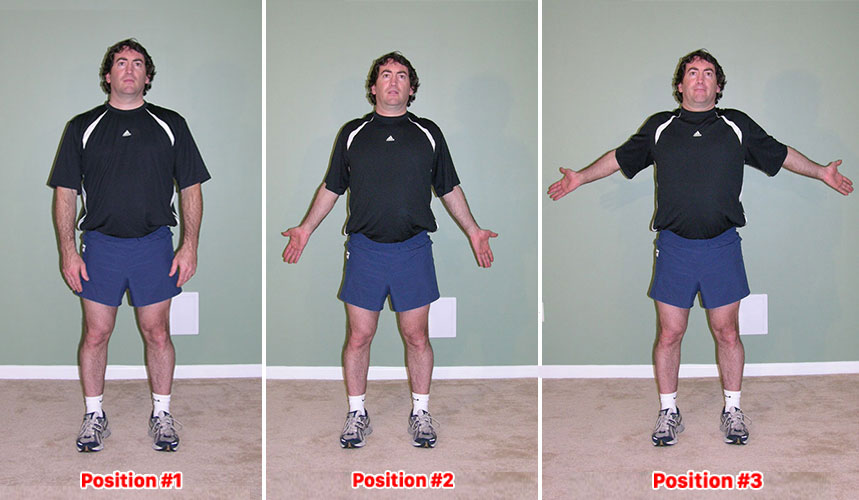
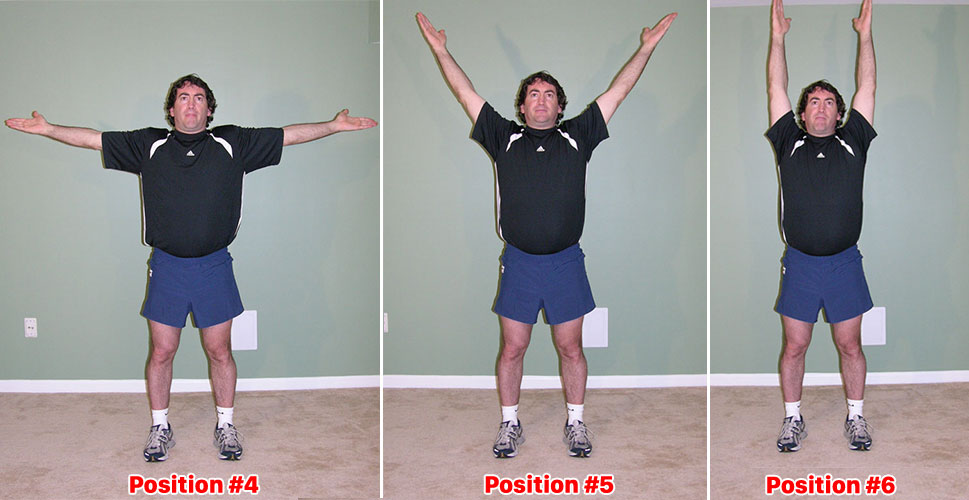
Directions:
- Stand with arms at your sides.
- At each of the five positions, your arms should be rotated outward and then pulled back as far as you can.
- Position #1: Your arms are extended downward toward your hips. Position #3: Your arms should be level with your shoulders. Position #5: Your arms should be directly over your head.
- Hold each position for 2-3 seconds, then slowly bring your arms back to your sides.
- Repeat 3-5 times, at least once per day.
Seated side bend
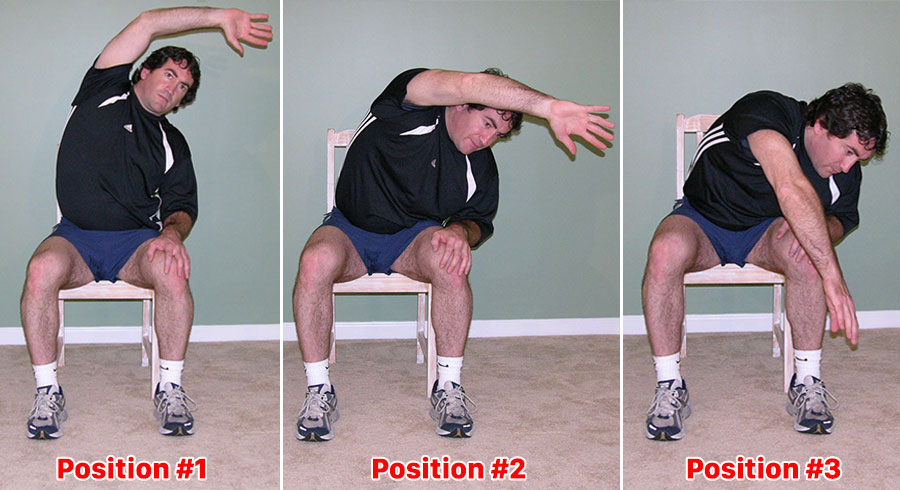
Directions:
- While seated on a chair, slowly bring the hand of the high hip hand over your head and reach forward toward the opposite foot.
- Hold for 3-5 seconds.
- Slowly return to the start position.
- Repeat 5-8 times, at least once per day.
Lat pull in doorway
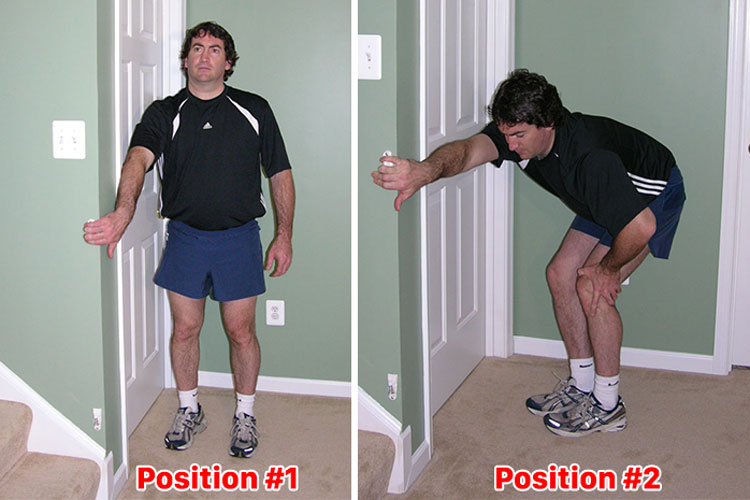
Directions:
- In a standing position, grab hold of the corner of a wall or doorway with the hand of the high hip side.
- Push back away from the wall or doorway, rotating your body slightly to get the best stretch possible.
- Hold for 3-5 seconds.
- Slowly return to the starting position.
- Repeat 5-8 times, at least once per day.
External rotation with exercise band

For this exercise, you will need an exercise resistance band.
Directions:
- Secure one of an exercise/resistance band between a door and door jamb.
- Stand with the injured side away from the door.
- Using your arm on the injured side, grip the free end of the band and hold it loosely. (Your elbow will be bent and your forearm will be across your abdomen,)
- Slowly extend your arm away from your body, keeping your elbow in place and close to your body.
- Hold for 3-5 seconds and return to starting position.
- Repeat 5-8 times, at least once per day.
These exercises are all part of the Muscle Balance Therapy program, the core strategy of my Lose the Back Pain System.
The Lose the Back Pain System has helped tens of thousands of people around the world eliminate their back pain by delivering a custom-designed program that addresses each person’s individual pain points and muscle imbalances.
You can learn more about the Lose the Back Pain System right here.
Key takeaway: Your body and muscles need to work in balance to heal and function properly, so make sure to not only stretch the latissimus dorsi, but also its opposing muscles.
How can I prevent latissimus dorsi pain?
Not all injuries can be prevented, but you can take steps to minimize your risk.
- Be vigilant about your posture, particularly when working at a computer workstation or when using your phone.
- Stay hydrated, especially before and after workouts.
- Practice self-massage or visit a qualified massage therapist.
- Continue to perform the stretches and exercises mentioned above as part of the Muscle Balance Therapy program.
Key Takeaway: By following the steps outlined above, you can lower your chances of your latissimus dorsi pain returning. Keep in mind, Muscle Balance Therapy is the single most effective strategy for resolving all types of muscle imbalances in the body and eliminating pain.
Final thoughts and key takeaways
By now, you should understand that most cases of latissimus dorsi pain are caused by muscle imbalances. And that resolving muscle imbalances can not only help you resolve your pain, but prevent it from returning in the future.
Having a balanced body is the key to living a pain-free life.
While it’s critical to resolve your muscle — or physical — imbalances, this is not the only area in which most people are imbalanced.
In order to live the healthiest life you need a more comprehensive approach.
Here at The Healthy Back Institute, we call that the Complete Healing Formula.
Along with muscle imbalances that cause pain, the Complete Healing Formula also addresses three other key areas that must be balanced in order to eliminate pain: nutritional, emotional and lifestyle.
4 Key takeaways about latissimus dorsi pain
> Latissimus dorsi pain is most often the result of muscle balances or postural dysfunction.
> For the best healing possible, I recommend a two-phase stretching regimen, taking care not to perform any stretches or exercises to the point of stress during the first 14 days.
> It is just as important to stretch and strengthen the lat’s opposing muscles when healing: the exterior rotators, the trapezoids and the anterior deltoids.
> Muscle Balance Therapy is the single most effective strategy for resolving latissimus dorsi pain, chronic muscle pain and all types of muscle imbalances in the body.
Read more:
5 Ways to Treat Pulled Back Muscles
Do This Move to Instantly Improve Your Posture and Well-Being
Updated: September 27,2018

